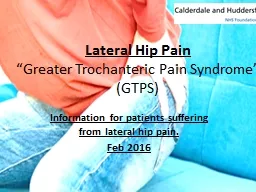

Greater Trochanteric Pain Syndrome GTPS Information for patients suffering from lateral hip pain Feb 2016 Greater trochanteric pain syndrome GTPS is a common clinical syndrome that ID: 543957
Download Presentation The PPT/PDF document "Lateral Hip Pain" is the property of its rightful owner. Permission is granted to download and print the materials on this web site for personal, non-commercial use only, and to display it on your personal computer provided you do not modify the materials and that you retain all copyright notices contained in the materials. By downloading content from our website, you accept the terms of this agreement.
Slide1
Lateral Hip Pain
“Greater Trochanteric Pain Syndrome” (GTPS)
Information for patients suffering from lateral hip pain.Feb 2016Slide2
Greater trochanteric pain syndrome – (GTPS) is a common clinical syndrome that used to be called trochanteric bursitis.More common in females F:M= 4:1More common in 40-60 year old patientsOccurs in 10-25% of the population Occurs in 35% with low back painSlide3
Patients usually complain of pain at the side of the hip radiating down the side of the thigh- and sometimes below the kneeSlide4
What makes it worse?WalkingSitting StandingGetting in and out of the carStairsLaying on the painful sideLaying on the opposite sideSlide5
What causes the pain?Research shows us that lateral hip pain is caused by wear and tear in the tendons of the muscles around your hip as they insert on the bone.Slide6
It is unlikely to be “bursitis”It used to be thought that the pain was caused by the sacs of fluid filled bursa around the tendons.But research shows us that it is most likely to be the tendons themselves that cause the pain.Slide7
“Why did this happen to me?”There are lots of reasons why this may have happened. But commonly this is down to the muscles’ inability to cope with the demands of daily life that are placed on them.You may have “asked” the muscles to do to much and they are not strong enough to cope with that demand.The tendons have been repeatedly compressed by the positions we adopt during daily life causing micro trauma to the tendon over time.Slide8
What happens next?This overload or compression to the tendon irritates the tendon, causing the muscle to become stiffer / tighter and tender to touch and can often refer pain down the leg.The muscle becomes weaker as we use it less, and so the cycle continues.Slide9
Tendon irritation due to overload or compression from day to day activitiesPain
Muscle fatigue and tightnessPain
Reduced hip range of motion
Lack of use
Gluteal weaknessSlide10
Positions during daily life that can compress the tendons.These positions often seen in people can cause continual micro trauma to the tendons over time. So if you can avoid these positions it can reduce your symptoms.Slide11
How can I ease my pain?Exercise to improve the hip muscle activation and strength is the best way to improve symptoms and stop it coming back in the future.Often patients are given an injection- and for some patients this can help reduce the pain temporarily- but this will not specifically address the route cause of your problem. Often patients’ pains return a few months later.
Try and avoid aggravating positions or activities that may induce compression on the tendons.Try some massage around the hip muscles
Try sleeping with a pillow between your knees, to prevent the leg falling across the body and compressing the top hip through over tensioning the thigh soft tissuesSlide12
What exercises should I try?
Put hand on pelvis and push the top leg nice and long.
This stacks the hips directly on top of each other.Relax and let the foot go floppy
Lift the leg up to hip height
Don’t let the hip hitch up
Push hard with the hand
Hold for 1 minute
Repeat 2-3 times
It should feel achy after the exercise just around your hip bone.
This static hold will help activate the hip muscle required to support your pelvis alignment and help decrease pain.
Side Leg lift holdSlide13
What exercises should I try?
1 leg balance- 30 secs
Stand on your worst leg
Keep your pelvis level
Don’t let it drop on the opposite side
Keep shoulders level
Don’t lean to the side
Keep your foot under your shoulder
Hold on to the wall if required so that you can feel the exercise working in the side of your hip of your standing legSlide14
What exercise should I try?
Put the worst leg on the step
Keep the back leg straightDO NOT bend and jump / push off the back leg.Peel the foot slowly from the heel to the toe as you step up
Push up slowly through the worst leg
Leave
the worst
leg on the step, and step down with the better leg. Slowly paste the foot back down
Keep your knee pointing forwards over your toes, don’t let it fall inwards as you step up and down
Step Ups